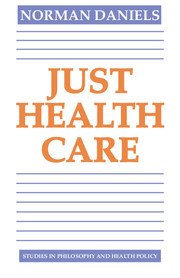Book contents
- Frontmatter
- Contents
- Preface
- Acknowledgements
- 1 Is health care special?
- 2 Health-care needs
- 3 Toward a distributive theory
- 4 Equity of access to health care
- 5 Am I my parents' keeper?
- 6 Doing justice to providers
- 7 Doth OSHA protect too much?
- 8 Risk and opportunity
- 9 Philosophy and public policy
- Works cited
- Index
7 - Doth OSHA protect too much?
Published online by Cambridge University Press: 05 June 2012
- Frontmatter
- Contents
- Preface
- Acknowledgements
- 1 Is health care special?
- 2 Health-care needs
- 3 Toward a distributive theory
- 4 Equity of access to health care
- 5 Am I my parents' keeper?
- 6 Doing justice to providers
- 7 Doth OSHA protect too much?
- 8 Risk and opportunity
- 9 Philosophy and public policy
- Works cited
- Index
Summary
Fair equality of opportunity and preventive health care
A health-care system can protect an individual's share of the normal opportunity range both by curing disease when it arises and by reducing the risks of disease and disability. If we are obliged to protect opportunity, we may neglect neither curative nor preventive measures. The fair equality of opportunity account thus has a bearing on the debate about whether the health-care systems of the United States and other western countries overemphasize acute therapeutic services as opposed to preventive and public-health measures. There are two general implications of the account for preventive health care: protecting opportunity will require (1) reducing the risk of disease and (2) seeking an equitable distribution of the risk of disease.
The first implication is fairly obvious. It is often more effective to prevent disease and disability than it is to cure them when they occur (or to compensate individuals for loss of function, where cure is not possible). Cost-effectiveness arguments will have some bearing on claims about the appropriate distribution of acute vs preventive measures. But the general point emphasized by the equal opportunity account is that the burdens of disease – even where the disease can be treated, and leaving aside financial burdens – have effects on fair equality of opportunity. This suggests that many types of preventive service and practice which reduce the risk of disease will be given prominence in a system governed by the fair equality of opportunity principle.
- Type
- Chapter
- Information
- Just Health Care , pp. 140 - 179Publisher: Cambridge University PressPrint publication year: 1985



